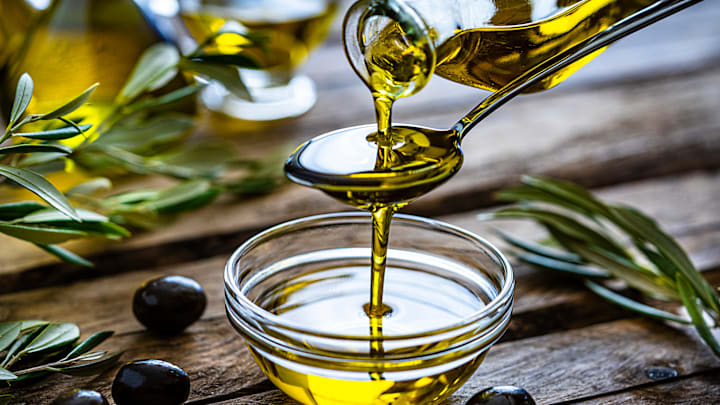Olive oil is incredibly versatile. Whether you’re making spaghetti aglio e olio or baked salmon, olive oil brings a dish together with a drizzle and can elevate even the simplest meal, from a Greek salad to a slice of pizza fresh out of the oven.
In fact, it’s good for desserts too, like olive oil cake and olive oil brownies. Olive oil can even be beneficial for skin and hair, reduce inflammation, and promote cardiovascular health as part of a Mediterranean diet.
But when it comes to olive oil, you might have noticed that there are different types: virgin, extra virgin, and pure. You’re likely to see all three at your local grocery store, but there isn’t usually much clarity surrounding what those three labels mean.
Ahead, you’ll learn more about the difference between pure, extra virgin, and virgin olive oil and why the term virgin is used in this context, plus the proper way to dispose of used cooking oil.
- What Exactly Is Extra Virgin Olive Oil?
- Virgin Olive Oil vs. Pure Olive Oil: What’s the Difference?
- How to Safely Get Rid of Cooking Oil
What Exactly Is Extra Virgin Olive Oil?
The gold standard when it comes to olive oil is extra virgin. During the creation process, whole Olea europaea olives are cold-pressed and unrefined with no heat or chemicals added to the final product. The temperature is kept low during the grinding process to enhance the flavor. As a result, extra virgin olive oil (EVOO) has the lowest percentage of free acidity, meaning no more than 0.8 percent fatty acid.
Yet, while it’s the most flavorful option because of the delicate and slow process that goes into making it, EVOO is also the most expensive. That means it may not be the best option for cash-strapped shoppers; the sticker price can be $10 to $20 a bottle.
Additionally, the term virgin refers to the methodology used to make olive oil. Although it’s made mechanically, olive oil is extracted using no heat or chemicals, ergo, virgin. As for the phrase extra virgin, this simply means that it’s held to a higher standard of processing, according to the International Olive Council and California Olive Oil Council, and depends on where it was produced.
Virgin Olive Oil vs. Pure Olive Oil: What’s the Difference?
While virgin olive oil (VOO) is also considered cold-pressed and unrefined, it has up to 2 percent free acidity, which means it contains more fatty acids than EVOO. It’s generally less expensive, which makes it more appealing to some shoppers. For most palates, it tastes roughly about the same as EVOO, too. That said, it’s not as premium in terms of quality as the extra virgin variety.
VOO and EVOO aren’t the only kinds of olive oil out there, even if they are the best known. Pure olive oil, also called “light” or “extra light,” is a blend of virgin and refined olive oils. During processing, oils are extracted from Olea europaea olives with heat and/or chemicals instead of being cold-pressed (unrefined); this is later mixed with VOO. Technically, pure olive oil is of a lower quality and is a bit closer to corn or vegetable oil than VOO or EVOO.
It’s frequently used for cooking or deep frying food instead of drizzling to bring a dish together. The terms pure, light, and extra light are used for marketing in this instance, as they also refer to the lighter color, flavor, and consistency when compared to VOO or EVOO.
How to Safely Get Rid of Cooking Oil
Once you’ve finished cooking, you may have some leftover cooking oil—whether it be EVOO, vegetable oil, canola oil, or just plain grease—left in your pan or deep fryer. If you choose not to reuse it, you’ll need to properly dispose of it, and therein lies the challenge for some novice cooks.
Instead of pouring it down your kitchen drain (which is not advisable), you should pour it into a mason jar—or any glass jar—using a funnel. Once it’s full, seal the jar with a lid or aluminum foil and let it cool. Once it has, you can chuck the jar into the dumpster. However, if you want to reuse that oil at some point, just place that mason jar in your freezer and keep it there until it’s completely frozen.
That oil should stay good for up to two years frozen, so there’s no need to use it right away. (And you’ll know if it’s gone bad because it will give off a pungent, rancid odor.) You could also toss the frozen jar in the trash after, too. It’s a safer way to dispose of the oil than pouring it down the drain, as that will lead to problems with clogging.
But that’s not the only way to get rid of old cooking oil. You can also use kitty litter to do it, which is arguably one of the most ingenious kitchen hacks of them all.
Have you got a Big Question you'd like us to answer? If so, let us know by emailing us at bigquestions@mentalfloss.com.
Read More About Food Below:
